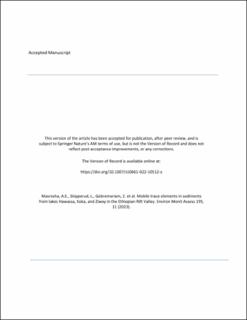| dc.description.abstract | The present work focuses on total concentrations of trace elements such as chromium (Cr), manganese (Mn), cobalt (Co), nickel (Ni), copper (Cu), zinc (Zn), arsenic (As), selenium (Se), cadmium (Cd), and lead (Pb) and their operationally defined speciation in surface sediments from three Ethiopian Rift Valley Lakes (Hawassa, Koka, and Ziway). Total concentrations were determined using inductively coupled plasma–mass spectrometer (ICP-MS). A six-step sequential extraction was also applied to evaluate the mobilization potential of these elements. Compared with the consensus-based sediment quality guidelines (SQGs) developed for freshwater ecosystems, the total Zn concentration in sediments from Lakes Hawassa and Ziway, as well as Cr, Ni, and Zn in sediments from Lake Koka, was higher than the probable effect concentration (PEC), suggesting that these elements could have a negative effect on benthic organisms. The sequential extraction results showed that Cd, Mn, and Se were to a certain extent associated with the reversible fractions (F1–F3) in sediments, and thereby more mobile than the other investigated trace elements. Predictions of mobility of trace elements using the distribution coefficients (Kd) values were also in agreement with the sequential extraction results. Furthermore, multivariate statistical analyses showed that redox-sensitive fractions (F4 and F6) and the residual fraction (F7) were the dominant factors controlling most trace element mobility. Finally, applying the Risk Assessment Code (RAC) classification system, results showed that Mn in Lake Koka could pose a high risk, while Cd and Mn in Lake Hawassa as well as Cd, Mn, and Se in Lake Ziway sediments could pose medium risk to benthic organisms. | en_US |
